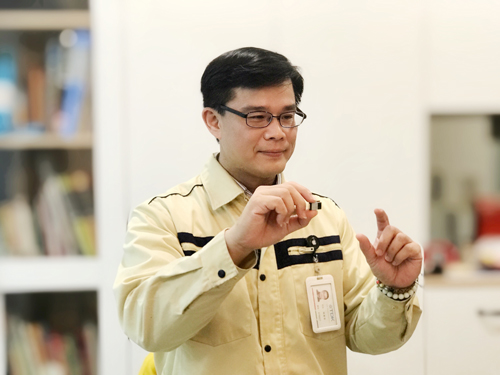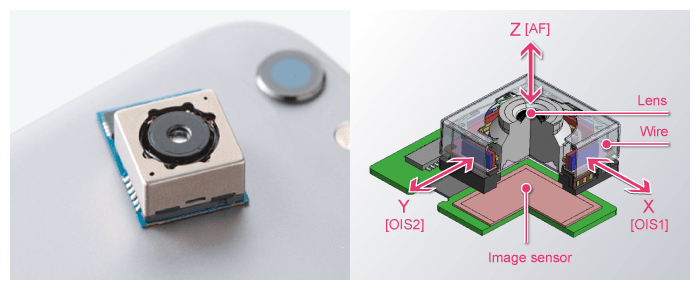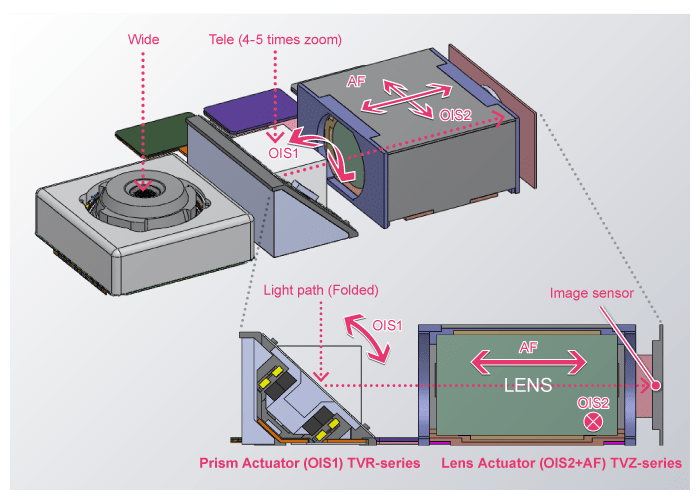What Enables a Smartphone Camera to Shoot a Full Moon Clearly without Camera Shake?
As Camera Lenses Become More Functional, Image Stabilization Becomes Ever More Important
Smartphone cameras keep evolving every year. Some models are even capable of shooting crisp, great-looking images like those taken with stand-alone digital cameras.
One factor that has driven camera functionality forward is the multiple-lens setup. More and more smartphones are being equipped with two, three, or four lenses, called dual, triple, or quad cameras, respectively. The availability of lenses with different characteristics enable an expanded range of photographic expression. One of them is high-quality zoom photography. A camera that combines more than one lens with different focal lengths*2 and fields of view allows zooming into a subject with less degradation in quality. This is because such cameras use optical zoom, instead of digital zoom which simply magnifies a portion of an image that has been taken. Smartphone cameras with optical zoom have become very popular.
Market Outlook for Smartphone Cameras

Market Breakdown of Camera Phone -2nd Half 2019 & 1st Half 2020 Forecast- TECHNO SYSTEMS RESEARCH CO.,LTD.
More recent models of smartphones feature high-magnification zoom cameras with as much as several tens of times’ magnification, allowing sharp images of even the craters of the moon to be captured from the earth. This type of photography, however, tends to result in blurred images due to camera shake. Zoom photography (i.e. images taken with a long focal length) makes a subject appear larger, which amplifies the effect of camera shake. Shooting in low light, such as at nighttime, often requires slower shutter speeds, which also contributes to camera shake. Even worse, smartphones have a structural weakness, in that their shapes are more prone to camera shake compared to regular digital cameras. And because higher image resolutions make blurring more noticeable, reducing camera shake has become a major challenge for smartphone cameras.
Lens Actuator Solutions Based on Combination OIS Products that Correct Camera Shake on Smartphone Cameras
 Micro-actuator Solutions BG
Micro-actuator Solutions BGTDK Taiwan Corporation Division Director
Dr. Aaron Hu
The solution to this challenge is the Camera Module Actuator (CMA) used in Optical Image Stabilization (OIS). The CMA corrects camera shake in zoom photography with the actuator moving the position of the lens to cancel out abrupt movements caused by shaking. Aaron Hu, Division Director at TDK Taiwan Corporation who developed the product, explains this technology.
“Camera shake occurs when the position of the light source, as recognized by the image sensor, moves between the beginning and the end of a shot. OIS compensates for this movement. TDK has been working on OIS since the early days of smartphone cameras. For instance, using wire suspension*3 as a supporting component for OIS is now a common practice in the industry, but we were among the first to incorporate it into development. This has enabled smoother operation and greater control of OIS, resulting in improved image stabilization.”
TDK’s OIS delivers powerful image stabilization through a system driven along triple (x-, y-, and z-) axes, and is adopted by smartphones all around the world. As smartphone cameras feature increasingly higher image resolutions, the lens apertures have become larger, thus requiring OIS actuators with greater drive power. To address this issue, TDK has introduced shape-memory alloys (SMA*4) with thicknesses as little as 25μm*5, offering a lineup of products with some of the industry’s highest drive power packed into small case sizes.
TDK was also among the world’s first to have developed an OIS system that supports high-magnification zoom cameras with as much as several tens of times’ magnification. This is achieved by a combination of OIS products that correct camera shake by moving both, the prism*6 as well as the lens. A prism actuator OIS and a lens actuator OIS are mounted in a space as small as 12 mm x 17.6 mm x 5.6 mm.
“With our design technologies that leverage proprietary simulation and manufacturing technologies for actuators accumulated over many years, we have successfully brought very challenging products like prism actuators and combination products to life. We were able to stay ahead of the pack in developing these technologies because smartphone manufacturers recognized TDK’s track record, and turned to us early on to discuss OIS for zoom lenses,” said Hu.
In regards to future prospects for smartphone cameras, Hu said, “We expect to see a rise in demand for continuous zoom, which allows you to transition from wide angle to telephoto as you can with a digital camera. Our goal is to create an OIS that corrects camera shake there. We are also looking to apply our autofocus CMA to AR functionalities that are expected to come into practical use with smartphone cameras, and continue to pioneer the creation of new, more convenient worlds.”
Terminology
- OIS: Technologies commonly used to correct camera shake in smartphone cameras include OIS (Optical Image Stabilization) and DIS (Digital Image Stabilization).
- Focal length: The focal length of a lens is the distance from the center of the lens to the image sensor. It is typically represented in millimeters (mm); lenses with smaller numbers provide a larger field of view and are called wide lenses, while those with higher numbers are capable of focusing on things farther away and are called telephoto lenses.
- Wire suspension: A wire spring primarily designed to suspend a lens, such as a camera module or an optical pickup.
- SMA: Shape-memory alloy: An alloy that can be deformed but returns to its pre-deformed shape when heated to a given temperature.
- μm (micrometer): 1 μm is equal to 1/1000 mm, or 1/1000000 m.
- Prism: A triangular column of transparent material such as glass that refracts and disperses light. In smartphone cameras, it is used to bend light rays, etc.




